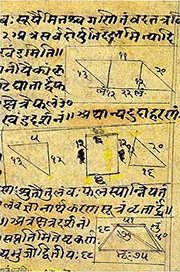Shitarashmi, Śītaraśmi, Shita-rashmi, Sitarashmi, Sitaraśmi, Sita-rashmi: 10 definitions
Introduction:
Shitarashmi means something in Buddhism, Pali, Hinduism, Sanskrit, the history of ancient India. If you want to know the exact meaning, history, etymology or English translation of this term then check out the descriptions on this page. Add your comment or reference to a book if you want to contribute to this summary article.
The Sanskrit terms Śītaraśmi and Sitaraśmi can be transliterated into English as Sitarasmi or Shitarashmi or Sitarashmi, using the IAST transliteration scheme (?).
In Hinduism
Ganitashastra (Mathematics and Algebra)
Source: archive.org: Hindu MathematicsŚītaraśmi (शीतरश्मि) represents the number 1 (one) in the “word-numeral system” (bhūtasaṃkhyā), which was used in Sanskrit texts dealing with astronomy, mathematics, metrics, as well as in the dates of inscriptions and manuscripts in ancient Indian literature.—A system of expressing numbers by means of words arranged as in the place-value notation was developed and perfected in India in the early centuries of the Christian era. In this system the numerals [e.g., 1—śītaraśmi] are expressed by names of things, beings or concepts, which, naturally or in accordance with the teaching of the Śāstras, connote numbers.

Ganitashastra (शिल्पशास्त्र, gaṇitaśāstra) refers to the ancient Indian science of mathematics, algebra, number theory, arithmetic, etc. Closely allied with astronomy, both were commonly taught and studied in universities, even since the 1st millennium BCE. Ganita-shastra also includes ritualistic math-books such as the Shulba-sutras.
In Buddhism
Tibetan Buddhism (Vajrayana or tantric Buddhism)
Source: Wisdom Library: Tibetan BuddhismSitaraśmi (सितरश्मि) is the name of an Uṣṇīṣa king [i.e., Uṣṇīṣarāja] mentioned as attending the teachings in the 6th century Mañjuśrīmūlakalpa: one of the largest Kriyā Tantras devoted to Mañjuśrī (the Bodhisattva of wisdom) representing an encyclopedia of knowledge primarily concerned with ritualistic elements in Buddhism. The teachings in this text originate from Mañjuśrī and were taught to and by Buddha Śākyamuni in the presence of a large audience (including Sitaraśmi).

Tibetan Buddhism includes schools such as Nyingma, Kadampa, Kagyu and Gelug. Their primary canon of literature is divided in two broad categories: The Kangyur, which consists of Buddha’s words, and the Tengyur, which includes commentaries from various sources. Esotericism and tantra techniques (vajrayāna) are collected indepently.
India history and geography
Source: Cologne Digital Sanskrit Dictionaries: Indian Epigraphical GlossaryŚītaraśmi.—(IE 7-1-2), ‘one’. Note: śītaraśmi is defined in the “Indian epigraphical glossary” as it can be found on ancient inscriptions commonly written in Sanskrit, Prakrit or Dravidian languages.

The history of India traces the identification of countries, villages, towns and other regions of India, as well as mythology, zoology, royal dynasties, rulers, tribes, local festivities and traditions and regional languages. Ancient India enjoyed religious freedom and encourages the path of Dharma, a concept common to Buddhism, Hinduism, and Jainism.
Languages of India and abroad
Sanskrit dictionary
Source: DDSA: The practical Sanskrit-English dictionaryŚītaraśmi (शीतरश्मि).—
1) the moon.
2) camphor.
Derivable forms: śītaraśmiḥ (शीतरश्मिः).
Śītaraśmi is a Sanskrit compound consisting of the terms śīta and raśmi (रश्मि). See also (synonyms): śītamayūkha, śītamarīci.
--- OR ---
Sitaraśmi (सितरश्मि).—the moon; शैलरुद्धवपुषः सितरश्मेः (śailaruddhavapuṣaḥ sitaraśmeḥ) (khe rarāja nipatatkara- jālam) Kirātārjunīya 9.19.
Derivable forms: sitaraśmiḥ (सितरश्मिः).
Sitaraśmi is a Sanskrit compound consisting of the terms sita and raśmi (रश्मि).
Source: Cologne Digital Sanskrit Dictionaries: Shabda-Sagara Sanskrit-English DictionarySitaraśmi (सितरश्मि).—m.
(-śmiḥ) The moon. E. sita white, and raśmi a ray.
Source: Cologne Digital Sanskrit Dictionaries: Benfey Sanskrit-English DictionaryŚitaraśmi (शितरश्मि).—m. the moon, [Śṛṅgāratilaks] 6.
Śitaraśmi is a Sanskrit compound consisting of the terms śita and raśmi (रश्मि).
Source: Cologne Digital Sanskrit Dictionaries: Cappeller Sanskrit-English DictionaryŚītaraśmi (शीतरश्मि).—[adjective] cold-rayed ([abstract] tva [neuter]); [masculine] the moon.
Source: Cologne Digital Sanskrit Dictionaries: Monier-Williams Sanskrit-English Dictionary1) Śītaraśmi (शीतरश्मि):—[=śīta-raśmi] [from śīta] mfn. cool-rayed (-tva n.), [Śakuntalā]
2) [v.s. ...] m. the moon, [Mahābhārata; Harivaṃśa; Kāvya literature]
3) [v.s. ...] Var camphor, [Monier-Williams’ Sanskrit-English Dictionary]
4) Sitaraśmi (सितरश्मि):—[=sita-raśmi] [from sita] m. ‘wh°-rayed’, the moon, [cf. Lexicographers, esp. such as amarasiṃha, halāyudha, hemacandra, etc.]
Source: Cologne Digital Sanskrit Dictionaries: Yates Sanskrit-English DictionarySitaraśmi (सितरश्मि):—[sita-raśmi] (śmiḥ) 2. m. The moon.
[Sanskrit to German]
Sanskrit, also spelled संस्कृतम् (saṃskṛtam), is an ancient language of India commonly seen as the grandmother of the Indo-European language family (even English!). Closely allied with Prakrit and Pali, Sanskrit is more exhaustive in both grammar and terms and has the most extensive collection of literature in the world, greatly surpassing its sister-languages Greek and Latin.
See also (Relevant definitions)
Partial matches: Sita, Rashmi.
Starts with: Shitarashmija, Shitarashmitva.
Ends with: Ashitarashmi.
Full-text: Shitarashmitva, Shitarashmija, Rashmi, Shitamayukha, Shitamarici, Shriputra, Sharadija.
Relevant text
Search found 2 books and stories containing Shitarashmi, Śītaraśmi, Shita-rashmi, Śīta-raśmi, Sitarasmi, Sita-rasmi, Sitarashmi, Sitaraśmi, Sita-rashmi, Sita-raśmi, Śitaraśmi, Śita-raśmi; (plurals include: Shitarashmis, Śītaraśmis, rashmis, raśmis, Sitarasmis, rasmis, Sitarashmis, Sitaraśmis, Śitaraśmis). You can also click to the full overview containing English textual excerpts. Below are direct links for the most relevant articles:
The Skanda Purana (by G. V. Tagare)
Chapter 7 - The Appearance (Origin) of Somanātha < [Section 1 - Prabhāsa-kṣetra-māhātmya]
Maha Prajnaparamita Sastra (by Gelongma Karma Migme Chödrön)
III. Exhortations to the practice of the six perfections (pāramitā) < [Part 3 - Establishing beings in the six perfections]